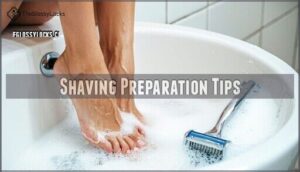This site is supported by our readers. We may earn a commission, at no cost to you, if you purchase through links.

Most people find shaving every 2-3 days works well, but you might need more frequent sessions if your hair grows quickly.
There’s no one-size-fits-all answer – some shave daily while others go weekly.
Your skin type matters too; sensitive skin often needs more recovery time between sessions.
You don’t need to follow arbitrary rules about when to shave legs – it’s about what feels right for your body.
The right technique can actually be more important than frequency for maintaining smooth, healthy skin, considering your personal preference and skin sensitivity are key to determining the best approach for smooth, healthy skin.
Table Of Contents
- Key Takeaways
- Shaving Frequency Basics
- How Often Shave Legs
- Shaving Techniques Matter
- Razor Care Essentials
- Shaving Preparation Tips
- Avoiding Skin Irritation
- Shaving Frequency Guidelines
- Post-Shave Care Routine
- Maintaining Healthy Skin
- Frequently Asked Questions (FAQs)
- Can I shave 2 days after shaving?
- How often should I remove leg hair?
- How often should I shave for growth?
- Can I shave legs during pregnancy?
- How does menstruation affect leg hair growth?
- Should seasons change my shaving routine?
- Are electric razors better than manual ones?
- Is professional waxing worth the investment?
- Conclusion
Key Takeaways
- Your ideal shaving frequency depends on your hair growth rate—typically every 1-3 days for fast growth, 2-4 days for moderate growth, or weekly for slow growth.
- You’ll get better results by focusing on proper technique rather than frequency—shave with the grain to reduce irritation or against it for closer results based on your skin’s sensitivity.
- You should prioritize razor maintenance by replacing blades every 5-10 uses and storing razors in dry places to prevent irritation and extend blade life.
- Your post-shave routine matters just as much as shaving itself—apply moisturizer immediately after shaving and exfoliate regularly to prevent ingrown hairs and maintain healthy skin.
Shaving Frequency Basics
Shaving your legs doesn’t have a one-size-fits-all answer—it depends on how quickly your hair grows and what makes you feel comfortable.
Understanding the basics of hair growth and common shaving myths can help you decide what works best for you, considering the basics of hair growth.
Hair Growth Rate Variations
Hair growth varies for everyone, impacting leg shaving frequency.
Factors like genetics, hormones, and age influence how fast your hair follicles work.
Body location plays a role too—leg hair doesn’t grow as quickly as scalp hair.
Good nutrition helps, so eat well, and on average, hair grows about 0.5 inches monthly, but your rate may differ.
Shaving Myths Debunked
Did you know shaving myths are everywhere?
Despite popular belief, cutting hair doesn’t alter its growth speed or thickness—these are “Thickness Myth” tales.
Hair appears coarse post-shave because stubble grows bluntly.
“Keratin Truth”? Hair is dead protein beyond follicles.
Shaving frequency myths debunked: shave as desired—your follicles won’t know.
Leg shaving frequency depends on you!
Shaving cream helps more than you think because it can protect and nourish your skin.
Individual Shaving Needs
Your shaving schedule depends on your shaving goals, skin sensitivity, and lifestyle factors.
Here’s a short, engaging blockquote in the same tone as the content:
Shave on your schedule, not society’s—your comfort level with stubble is the only rule that matters.
Everyone’s personal hair growth and comfort levels vary, so there’s no perfect answer for how often to shave legs.
Remember to think about pre-shave skin preparation for best results.
Consider these three points:
- Fast growth? Aim for every 1-3 days.
- Moderate growth? Every 3-5 days suits most.
- Slow growth? Once a week is fine.
How Often Shave Legs
How often you shave your legs depends on factors like your hair type, growth rate, and personal preference.
There’s no single right answer, so it’s all about what makes you feel most comfortable.
Factors Affecting Shaving Frequency
Your leg-shaving habits depend on a mix of factors, including hair growth, skin sensitivity, your personal schedule, and even seasonal changes.
These factors all play a part in determining how often you should shave your legs. Some prioritize smooth legs year-round, while others embrace stubble in winter.
To achieve the best results, consider preparing your skin properly before shaving.
Here’s a quick guide to help you understand the impact of different factors on your shaving frequency:
| Factor | Impact on Frequency | Examples | Tips |
|---|---|---|---|
| Hair Growth | Faster growth = more often | Thick hair | Shave 2-3 days |
| Skin Sensitivity | Irritated skin = less often | Dry or sensitive skin | Focus on proper prep |
| Personal Schedule | Busy days = longer gaps | Travel, packed routines | Shave weekly |
| Seasonal Changes | Bare legs in summer | Shorts, swimsuits | More frequent in warm months |
Hair Type and Growth Rate
Your unique biology substantially influences how often you shave your legs.
Understanding your hair type and growth rate helps establish an effective routine.
Here are 5 key factors affecting your leg hair growth:
- Hair texture (straight grows most visibly, coily appears slowest)
- Growth stages (anagen, catagen, telogen cycles)
- Genetic factors (determine baseline growth speed)
- Hair color (darker hair may require more frequent shaving)
- Hormonal influence (impacts growth patterns throughout life)
Personal Preference and Comfort
Your comfort level with stubble tolerance ultimately determines your ideal shaving frequency.
Some women prefer bare legs daily, while others embrace natural hair growth or only shave for special occasions.
There’s no "right" answer for how often to shave—it’s entirely your personal preference.
Dermatologists advise prioritizing technique over frequency for healthy skin.
Your shaving routine should align with what makes you feel confident and comfortable.
Shaving Techniques Matter
Your shaving technique affects your skin’s health just as much as how often you shave.
You’ll achieve smoother results and prevent irritation by adapting your approach to your specific hair type and growth pattern.
Shaving With The Grain
In terms of achieving smooth legs, shaving with the grain (following your hair growth direction) is your best defense against irritation.
This gentle shaving technique substantially reduces razor bumps and folliculitis by working with your body’s natural patterns.
For most people, this means shaving downward on legs, which mightn’t provide the closest shave, but it’s much kinder to your skin and minimizes those painful red bumps, making it a technique that helps prevent irritation.
Shaving Against The Grain
Shaving against the grain offers a closer shave but requires careful technique refinement.
When you move the razor upward on your legs (opposite to hair growth direction), you’ll notice:
- Substantially smoother results than with-grain shaving
- Higher irritation risk, especially for sensitive skin
- Need for reapplication of shaving gel before each pass
- Increased chance of razor burn if done improperly
- Better results when used as a second pass after with-grain shaving
This method has its advantages and disadvantages, and understanding these points is crucial for a successful shave.
Adjusting Technique for Hair Type
While shaving against the grain gives you a closer shave, your hair type should determine your specific technique.
For curly hair, go with the grain to prevent ingrown hairs. Straight hair tolerates against-the-grain shaving better.
Fine hair requires gentle pressure, while coarse hair needs sharp razors and thorough preparation.
If you have sensitive skin, always use a moisturizing shaving gel and fresh blades. Your leg shaving frequency might vary, but technique matters more.
Razor Care Essentials
You’ll need to properly maintain your razor for safe and effective leg shaving results.
Taking care of your shaving tools prevents skin irritation and extends the life of your blades, saving you both discomfort and money.
Replacing Razor Blades
When razor blades wear out, your smooth shaving experience goes downhill fast.
For best hygiene practices and sharpness, replace blades every 5-10 uses or when you notice tugging on your skin.
Blade lifespan varies based on shaving frequency and hair thickness.
Watch for rust prevention by changing blades showing signs of oxidation immediately.
Consider buying replacement blades for convenience.
Your shaving routine deserves fresh razor blades – your legs will thank you for maintaining this simple replacement frequency.
Cleaning and Storing Razors
Regarding proper razor maintenance, cleaning and storing your razor correctly can dramatically extend its lifespan while ensuring skin safety.
Here are five essential razor cleaning and storage practices:
- Rinse thoroughly between strokes to prevent buildup
- Use warm water after shaving to remove all residue
- Tap gently to remove excess water before storage
- Store in a dry location away from shower moisture
- Consider a blade cover to prevent rust formation
By following these practices, you can ensure your razor remains in good condition, which is crucial for skin safety.
Maintaining Razor Sharpness
Now that your razor is clean and properly stored, let’s focus on keeping it sharp. Your blade’s performance directly impacts your shaving experience.
| Blade Material | Maintenance Need | Sharpness Lifespan |
|---|---|---|
| Stainless Steel | Weekly cleaning | 5-7 shaves |
| Carbon Steel | After each use | 3-5 shaves |
| Titanium-Coated | Bi-weekly cleaning | 8-10 shaves |
Watch for signs of razor dullness like tugging or irritation. Replacement frequency varies, but most razor blades need changing after 5-10 uses, which affects the overall shaving experience and requires regular maintenance.
Shaving Preparation Tips
Proper preparation before shaving can make the difference between smooth legs and irritated skin.
You’ll need to exfoliate and hydrate your skin with warm water before applying a quality shaving gel to create the ideal surface for your razor to glide across.
Exfoliating Before Shaving
Just as clean blades prevent issues, properly prepped skin is your secret weapon.
Exfoliation before shaving removes dead skin cells that can clog your razor and trap hairs.
For smooth legs, gently use a scrub or exfoliating mitt in circular motions 24 hours before shaving.
This skin exfoliation prevents ingrown hairs and allows for a closer shave.
Different scrub types work for various skin sensitivities – loofahs for normal skin, chemical exfoliants for sensitive areas.
Hydrating The Skin
Now that your skin is exfoliated, proper hydration prepares your legs for a smooth shave. Well-hydrated skin creates the perfect canvas.
- Warm water softens hair follicles, making them easier to cut
- Skin hydration reduces friction between razor and skin
- Moisturizing ingredients in shaving creams provide protection
- Proper hydration minimizes chances of nicks and irritation
Avoid dry shaving at all costs—it’s like trying to glide over sandpaper rather than silk.
Choosing The Right Shaving Gel
The marketplace shelf of shaving products can be overwhelming.
When choosing the right shaving gel, consider your skin type and sensitivity level. Look for hydrating ingredients like aloe vera or glycerin for dry skin, while oily skin benefits from lighter formulations.
Unscented options work best for sensitive skin to prevent irritation. Consider product options available for different skin types.
Apply shaving gel evenly in circular motions, ensuring complete coverage before the razor touches your skin, using the right shaving gel for a smooth experience, and following proper techniques for the best shaving results.
Avoiding Skin Irritation
You’ll minimize skin irritation when shaving your legs by using the right technique and maintaining your tools properly.
Shaving with the grain of your hair growth, using sharp blades rather than dull ones, and applying gentle pressure will substantially reduce your risk of razor burn, cuts, and uncomfortable bumps.
Shaving in The Right Direction
Now that your skin is properly prepped, let’s focus on how you move that razor.
Shaving in the right direction makes all the difference for your skin’s health. Direction matters when shaving legs – generally, go with the grain (downward) for sensitive skin to prevent irritation.
For a closer shave, try against grain shaving upward, but use lighter pressure control.
Regular razor cleaning is important to prevent bacteria buildup.
This technique adjustment reduces bumps and cuts while still achieving smooth results.
Using Sharp Razors
Your trusty razor’s sharpness substantially impacts your shaving experience.
Dull blades cause irritation and increase the risk of ingrown hairs, requiring multiple passes over the same area.
For ideal shaving frequency, replace razor blades every five to seven uses and watch for blade dullness signs like tugging or discomfort.
Quality blade material and proper multi-blade benefits guarantee a smoother shave with less irritation, making your leg-shaving routine more effective and comfortable.
Applying Gentle Pressure
Many inexperienced shavers press too hard when shaving, leading to unnecessary skin irritation. Applying gentle pressure is essential for preventing nicks and cuts while maintaining smooth results.
For best shaving techniques with sensitive skin, it is crucial to follow a few guidelines.
- Hold your razor with fingertips, not a tight grip
- Let the razor’s weight do the work
- Use short, light strokes rather than long, forceful ones
- Rinse between strokes to minimize razor burn and ensure a smoother shave, which is key to preventing irritation and achieving smooth results.
Shaving Frequency Guidelines
You’ll need to adjust your shaving routine based on your natural hair growth rate, which can vary from every 1-3 days for fast growth to every 3-5 days for slower growth.
The ideal frequency depends on your personal preference for smoothness and your skin’s sensitivity to frequent razor contact.
Fast Hair Growth Shaving
Now that you know how to minimize skin irritation, let’s address fast hair growth shaving. If you’re blessed with speedy hair growth, you’ll likely need to shave every 1-3 days for consistently smooth legs.
| Fast Growth Shaving | Managing Stubble |
|---|---|
| Morning routine | Use fresh blades |
| Every 2-3 days | Apply moisturizer daily |
| With grain first | Exfoliate between shaves |
| Against grain for closeness | Use quality razor |
| Light pressure always | Keep skin hydrated |
To achieve smooth legs and manage stubble effectively, consider the provided table as a guide for your shaving routine, emphasizing the importance of moisturizer and exfoliate to keep your skin healthy and hydrated.
Moderate Hair Growth Shaving
If your leg hair grows at a moderate rate, you’ll typically achieve the best balance between smoothness and convenience with a consistent shaving routine.
For moderate hair growth, consider these shaving frequency guidelines:
- Every 2-3 days maintains consistent smoothness
- Observe your personal stubble tolerance level
- Adjust based on skin sensitivity reactions
- Consider lifestyle factors like special events
- Remember smoothness duration varies by individual
Your ideal frequency depends on your preference, not myths about increased growth; in fact, shaving doesn’t impact hair thickness or regrowth rate.
Slow Hair Growth Shaving
While moderate growth requires regular attention, those blessed with slow hair growth enjoy more freedom in their shaving routines.
If you’re among this lucky group, your shaving frequency choices may extend to every 3-5 days while maintaining smooth skin.
| Slow Growth Benefits | Practical Tips | Maintenance Schedule |
|---|---|---|
| Extended smoothness duration | Focus on post-shave moisturizing | Every 3-5 days |
| Less frequent irritation | Use sharp blades for minimal stubble | Weekly for special occasions |
| Reduced shaving time | Apply gentle pressure | Biweekly for winter months |
Post-Shave Care Routine
You’ll need to protect your freshly shaved skin by applying moisturizer immediately after shaving to restore hydration and create a protective barrier.
This simple step prevents razor burn and ingrown hairs while keeping your legs smooth and comfortable between shaves.
Moisturizing The Skin
Now that you’ve established your ideal shaving frequency, it’s time to focus on post-shave moisturizing. Your freshly shaved legs need hydration to maintain smoothness and prevent dryness.
Applying moisturizer immediately after shaving locks in moisture while your pores are still open.
Here’s a short, engaging blockquote in the same tone as the article:
Post-shave moisturizing is your skin’s best friend—sealing hydration while pores remain receptive to nourishment.
Here are 5 moisturizing options for post-shave leg care:
- Fragrance-free lotions with shea butter for sensitive skin
- Natural oils like coconut or jojoba that absorb quickly
- Aloe vera gel for cooling and soothing properties
- Ceramide-rich creams that strengthen skin’s barrier
- Lightweight body butters for long-lasting hydration
Consider shea butter products for superior skin hydration.
Treating Razor Burn
Razor burn’s angry red bumps can turn your smooth shaving experience into an uncomfortable ordeal.
When irritation strikes, try these proven remedies:
| Cooling Methods | Benefits |
|---|---|
| Aloe Vera | Soothes inflammation instantly |
| Hydrocortisone Cream | Reduces redness and itching |
| Unscented Moisturizers | Restores skin barrier |
| Cold Compress | Calms irritated skin |
| Loose Clothing | Prevents further friction |
Wear breathable fabrics until the irritation subsides, particularly when treating sensitive skin areas, to help minimize discomfort and support the healing process with unscented moisturizers.
Preventing Ingrown Hairs
While your skin heals from razor burn, let’s talk about preventing those pesky ingrown hairs.
To keep hair growing straight out instead of curling back, shave in the direction of hair growth and use as few strokes as possible.
Exfoliation methods (2-3 times weekly) help remove dead skin cells that trap hair, and proper skin hydration and moisturizing loosen dead skin.
While clothing choice matters too—wear looser items to reduce irritation after shaving sensitive skin, it’s also important to consider the overall impact of these methods on preventing ingrown hairs.
Maintaining Healthy Skin
You’ll maintain healthier skin when you establish a consistent shaving routine that includes proper preparation, technique, and aftercare.
Regular exfoliation, using sharp razors, and applying moisturizer will protect your skin barrier while preventing common issues like razor burn and ingrown hairs.
Shaving Best Practices
Your shaving success hinges on mastering a few fundamental best practices.
Apply minimal razor pressure to avoid nicks while gliding in the correct shaving direction—typically with the grain first.
Make technique adjustments based on your unique hair type and growth patterns.
Rinse frequently during shaving and maintain proper blade care.
For a closer shave, consider shaving against the grain.
Remember, ideal techniques matter more than shaving frequency for long-term skin health and smoother results.
Skin Health Benefits
Proper shaving routines do more than just remove hair—they can actually improve your skin’s health.
When you shave correctly, you’re exfoliating dead skin cells, which promotes cell renewal.
Your skin health benefits when you find the right shaving frequency that helps minimize irritation, prevent folliculitis, and reduce bumps.
Regular but not excessive shaving can avoid infections and promote healing, giving your legs that healthy glow without compromising your skin’s natural barrier, and this leads to overall better skin health with proper care.
Long-Term Shaving Strategies
To develop sustainable shaving frequency habits, focus on protecting your skin barrier health through consistent routines.
You’ll benefit from establishing a regular schedule based on your hair growth pattern rather than social pressure.
Consider razor subscription services to guarantee you’re never stuck with dull blades.
Alternating between shaving and other hair reduction methods gives your skin recovery time, preventing ingrown hairs while maintaining the smoothness you desire.
Frequently Asked Questions (FAQs)
Can I shave 2 days after shaving?
When it rains, it pours!
Yes, you can absolutely shave 2 days after your previous shave.
It’s perfectly safe for your skin, though you’ll likely have minimal stubble to remove at this point, with minimal being a key consideration.
How often should I remove leg hair?
The frequency for removing leg hair depends on your personal preference.
You can shave every 1-3 days for fast growth, 2-4 days for moderate growth, or 3-5 days for slow growth.
How often should I shave for growth?
Shaving doesn’t actually affect hair growth – it’s a common myth.
You can shave as often as you prefer for appearance, typically every 2-5 days depending on your hair growth rate and personal preference.
Can I shave legs during pregnancy?
Like a tightrope walker needing balance, you can safely shave during pregnancy.
Sit down, use sharp blades, plenty of shaving gel, and consider asking your partner for help when your belly makes reaching difficult.
How does menstruation affect leg hair growth?
Hormonal fluctuations during your period can temporarily increase hair growth speed.
You may notice slightly faster leg hair regrowth during menstruation, but this varies between individuals and typically isn’t dramatic enough to change your regular shaving routine.
Should seasons change my shaving routine?
When push comes to shove, seasons do matter for your shaving routine.
You’ll likely shave more in summer when legs are exposed, and can reduce frequency in winter when they’re covered up.
Are electric razors better than manual ones?
Both types have their merits.
Electric razors offer convenience and fewer nicks, while manual razors provide a closer shave.
Your skin sensitivity, time constraints, and desired smoothness should guide your choice.
Is professional waxing worth the investment?
Professional waxing provides longer-lasting smoothness (3-6 weeks) compared to shaving (1-3 days). You’ll experience less irritation and regrowth becomes finer over time, making it worth the investment for many.
Conclusion
Determining how often you should shave legs ultimately depends on your unique needs.
Consider your hair growth rate, skin sensitivity, and personal comfort when establishing your routine.
Remember that quality technique matters more than rigid schedules—using sharp razors, proper preparation, and adequate post-shave care will maintain healthier skin regardless of frequency.
Whether you’re a daily shaver or weekly groomer, listen to your body’s signals and adjust accordingly, focusing on what works best for your personal comfort and skin sensitivity.
The perfect shaving schedule is simply the one that works best for you.
- https://doi.org/10.1111/jsm.12763
- https://nyulangone.org/doctors/1215220496/arielle-r-nagler
- https://www.instagram.com/monagoharadermdoc/
- https://go.redirectingat.com/?id=74968X1525086&xs=1&url=https%3A%2F%2Favamd.com%2F&sref=https%3A%2F%2Fwww.seventeen.com%2Fhealth%2Fa28246434%2Fhow-often-should-you-shower%2F
- https://www.aad.org/public/everyday-care/skin-care-basics/hair/how-to-shave












